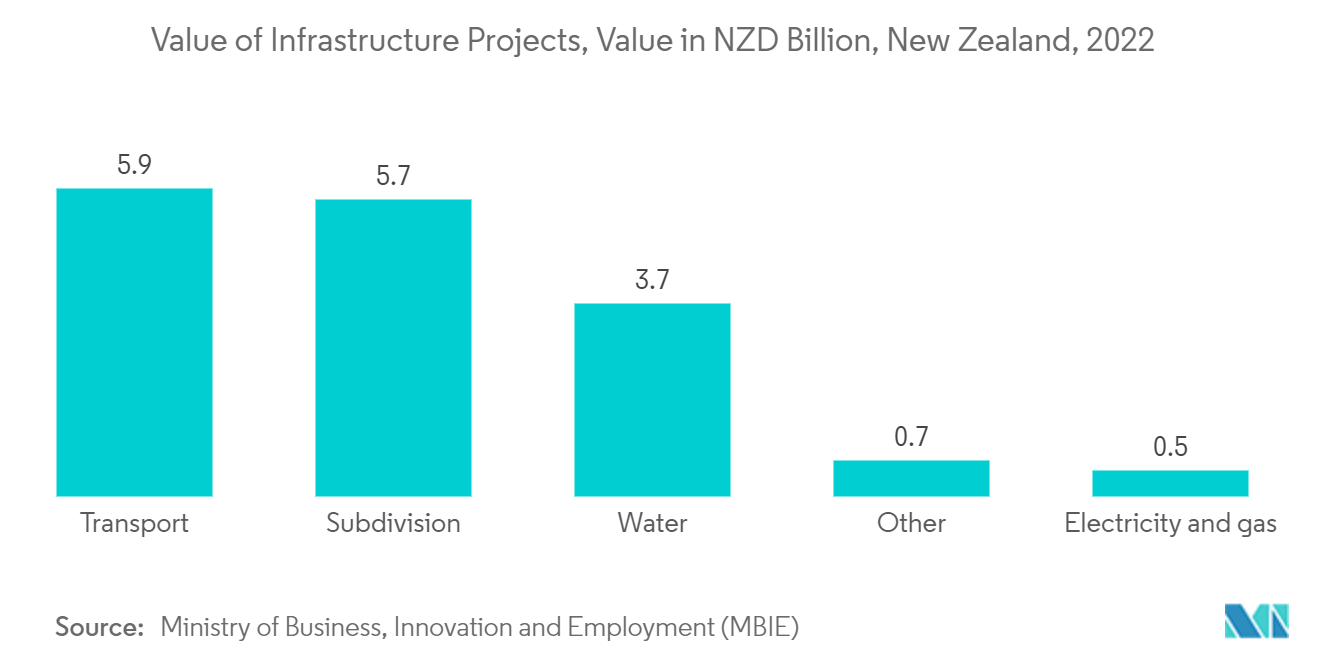Market Trends of New Zealand Infrastructure Sector
This section covers the major market trends shaping the New Zealand Infrastructure Sector Market according to our research experts:
Increasing Demand for Transport Infrastructure Driving the Market
In December 2022, New Zealand's Ministry of Transport announced nearly USD 350 million worth of transport infrastructure projects across the country. The package includes 397 new or upgraded bus stops to improve people's access to public transport, the construction of 242 kilometers of cycleways to encourage more cycling, improving 119 schools, and the construction of 11 new bus priority lanes. Auckland Transport has been allocated USD 75 million from this package, as Auckland Transport and the Ministry play a crucial role in providing a low-emission, climate-resilient future for the city.
In August 2022, a new transportation infrastructure plan was proposed for New Zealand's largest city. The plan aimed to reduce city traffic, and a budget of more than USD 129 million was planned to improve Auckland's traffic flow. In addition, the USD 1.29 billion budget is aimed at improving sustainable transport in the city, with a plan to install EV charging technology in homes, expand the city's cycling facilities, and introduce zero-emissions buses by 2030. The main aim of this project is to cut the private car utilization rate by more than 50%, encourage public transport usage, and cycle commuting from its present low of 1% to around 13%.
Meanwhile, in September 2022, the country's government invested in local infrastructure to support decarbonization. More than USD 30 million was planned to invest in the Streets for the People program. As per the Ministry of Business, Innovation, and Employment (MBIE), in 2022, transportation infrastructure projects dominated the infrastructure work by more than NZD 5.9 billion (USD 3.7 billion). Thus, the increasing demand for transportation infrastructure is driving the market.

Non-residential Buildings Witnessing Significant Growth
In 2022, the private sector was the largest initiator of non-residential buildings, contributing more than 66% of the non-residential buildings sector value, whereas central and local governments made up 22% and 13%, respectively. Post lockdowns, non-residential buildings such as shop refits and new storage and logistics facilities witnessed significant growth driven by increasing online sales. In 2022, industry experts saw growth in tourist facility projects to accommodate the visitors of the country.
In 2022, the building and construction sector was New Zealand's fourth-largest industry in terms of GDP contribution, and the industry was responsible for delivering much-needed housing, offices, and commercial buildings. The country's government is currently focusing on developing sustainable building standards for new government-owned non-residential buildings to support the Carbon Neutral Government Programme (CNGP). This program ensures government-owned buildings are designed to reduce embodied and operational carbon and waste, such as construction and demolition waste. These sustainability measures support future commercial projects in the country.
Meanwhile, in 2022, commercial buildings dominated non-residential building work by contributing more than 43% of the total number of projects and approximately 44% of the total value. In addition, planned visitor accommodation projects were delayed back in 2020. Currently, these projects are in the progress stage. Education projects also witnessed significant growth, contributing more than 23% of the total number of non-residential building projects.


